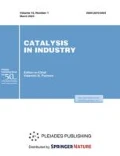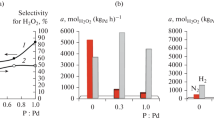Abstract
The selectivity toward products is studied for the industrially important process of NO hydrogenation in a H2SO4 solution as a function of process parameters: the hourly space velocity of the NO + H2 gas mixture through the reactor, the speed of stirring and the concentration of the Pt catalyst/graphite suspension, and the temperature. It is found that the first or zero order with respect to the catalyst can be observed for this process in the regime of external diffusion limitation for the gas reagents, depending on the concentration of the catalyst in the suspension, and the selectivity toward solid products (hydroxylamine sulfate (HAS) and ammonium sulfate) is greatest in the region of transition. It is shown that the selectivity towards HAS can be improved by functionalizing graphite surface with nitrogen-containing groups that modify the adsorption and catalytic properties of supported platinum nanoparticles. Some views are presented on specific features of the functioning of platinum catalysts in concentrated suspensions with a limited supply of the reaction gases.





Similar content being viewed by others
REFERENCES
US Patent 2628889, 1953.
US Patent 3060133, 1962.
US Patent 2823101, 1958.
US Patent 3663166, 1971.
US Patent 4477424, 1984.
US Patent 5554353, 1996.
US Patent 7037478, 2006.
US Patent 4048291, 1977.
US Patent 4889704, 1989.
US Patent 4895711, 1990.
US Patent 4992252, 1991.
US Patent 5155081, 1992.
US Patent 5120699, 1992.
US Patent 5236685, 1993.
US Patent 5560895, 1996.
US Patent 5817592, 1998.
US Patent 6083468, 2000.
Tauszik, G.R., and Crocetta, P., Appl. Catal., 1985, vol. 17, no. 1, pp. 1–21.
Van de Moesdijk, C.G.M., The catalytic reduction of nitrate and nitric oxide to hydroxylamine: kinetics and mechanism, PhD Thesis, Eindhoven: Technische Hogeschool,1979.
Savodnik, N.N., Kul’kova, N.V., Dokholov, D.M., Lopatin, V.L., and Temkin, M.I., Kinet. Katal., 1972, vol. 13, no. 6, pp. 1520–1526
Polizzi, S., Benedetti, A., Fagherazzi, G., Goatin, C., Strozzi, R., Talamini, G., and Toniolo, L., J. Catal., 1987, vol. 106, no. 2, pp. 494–499.
US Patent 3996165, 1976
US Patent 5496789, 1996.
Bobrovskaya, A.N., Simonov, P.A., Bukhtiyarov, A.V., Kvon, R.I., Rudina, N.A., Romanenko, A.V., and Khodorchenko, V.M., Catal. Ind., 2018, vol. 10, no. 4, pp. 279–287.
RF Patent 2530001, 2014.
RF Patent 2415707, 2011.
Voropaev, I.N., Simonov, P.A., and Romanenko, A.V., Russ. J. Inorg. Chem., 2009, vol. 54, no. 10, pp. 1531–1536.
Pels, J.R., Kapteijn, F., Moulijn, J.A., Zhu, Q., and Thomas, K.M., Carbon, 1995, vol. 33, no. 11, pp. 1641–1653.
Burg, Ph., Fydrych, P., Cagniant, D., Nanse, G., Bimer, J., and Jankowska, A., Carbon, 2002, vol. 40, no. 9, pp. 1521–1531.
Inagaki, M., Toyoda, M., Soneda, Y., and Morishita, T., Carbon, 2018, vol. 132, pp. 104–140.
Analiticheskii kontrol’ proizvodstva v azotnoi promyshlennosti (Analytical Control of Nitrogen Industry Production), vol. 19: Analiz produktov tsekha gidrirovaniya benzola i stochnykh vod proizvodstva kaprolaktama (Analysis of Benzene Hydrogenation Workshop Products and Caprolactam Production Wastewater), Moscow: Khimiya, 1971.
Paseca, I., Collect. Czech. Chem. Commun., 1981, vol. 46, no. 11, pp. 2669–2675.
Lopatin, V.L., Kul’kova, N.V., and Temkin, M.I., Kinet. Katal., 1982, vol. 23, no. 4, pp. 863–867.
Paseca, I., React. Kinet. Catal. Lett., 1979, vol. 11, no. 1, pp. 91–95.
Funding
This work was performed as part of a State Task for the Boreskov Institute of Catalysis.
Author information
Authors and Affiliations
Corresponding authors
Additional information
Translated by E. Glushachenkova
Rights and permissions
About this article
Cite this article
Bobrovskaya, A.N., Simonov, P.A., Kvon, R.I. et al. Synthesis of Hydroxylamine Sulfate via NO Hydrogenation over Pt/Graphite Catalysts, Part 2: Effect of the Reaction Conditions and the Physicochemical State of a Catalyst on the Yield of Products. Catal. Ind. 12, 16–28 (2020). https://doi.org/10.1134/S2070050420010031
Received:
Revised:
Accepted:
Published:
Issue Date:
DOI: https://doi.org/10.1134/S2070050420010031




